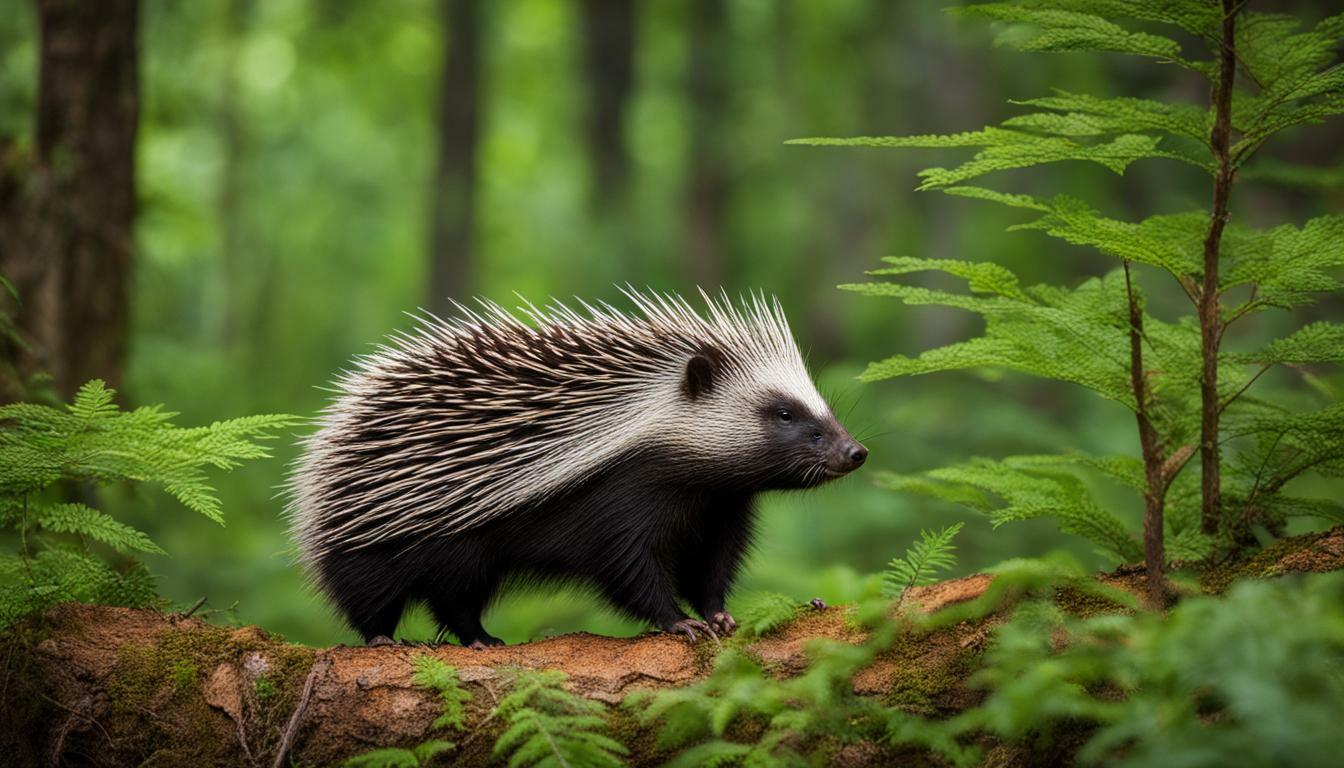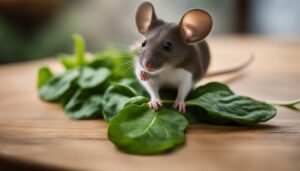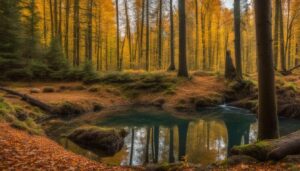Arkansas, known as the Natural State, is home to a diverse range of wildlife, but have you ever wondered if porcupines are among the native animals in Arkansas? According to various sources, porcupines are indeed found in Arkansas, particularly in wooded areas such as the Buffalo River. These nocturnal creatures feed on plants, nuts, bark, and twigs, and can also cause damage to trees by feeding on the bark. Porcupines play an important role in the local ecosystem by spreading seeds through their droppings and providing a food source for other wildlife.
There have been documented occurrences of porcupines in Arkansas, including a female specimen that was accidentally killed in Sevier County in 1984. This may indicate a range extension of the species in the state. However, it’s important to exercise caution around porcupines due to their sharp quills, which can cause serious injury. If you encounter a porcupine, it’s best to remain calm and slowly back away.
Should there be a high population of porcupines in a certain area leading to damage and conflicts with other wildlife, it is advisable to contact local wildlife agencies for guidance on trapping and relocating them.
Key Takeaways:
- Porcupines are indeed found in Arkansas.
- They can be spotted in wooded areas such as the Buffalo River.
- Porcupines are nocturnal and feed on plants, nuts, bark, and twigs.
- They play a role in the local ecosystem by spreading seeds and providing a food source for other wildlife.
- It’s important to exercise caution around porcupines due to their sharp quills.
Exploring Arkansas Wildlife
Before we delve into the presence of porcupines in Arkansas, let’s take a moment to appreciate the rich and varied wildlife that calls this state home. Arkansas is known for its diverse animal species, making it a haven for wildlife enthusiasts and nature lovers.
From majestic black bears to elusive bobcats, Arkansas is home to an impressive array of animals. The state’s unique geography, with its mountains, forests, and rivers, provides a diverse range of habitats that support a wide variety of species.
Whether you’re hiking in the Ozarks or exploring the swamps of the Mississippi Delta, you’re likely to encounter an abundance of wildlife. Arkansas is home to over 70 mammal species, including deer, coyotes, foxes, and various rodents. Its bird population is equally diverse, with over 400 species, including bald eagles, black vultures, and the painted bunting.
With its rich biodiversity, Arkansas offers endless opportunities for wildlife enthusiasts to observe and appreciate the wonders of nature. So, grab your binoculars and explore the untamed beauty of Arkansas’s wildlife, where every encounter is a chance to connect with the natural world.
| Mammals | Birds | Reptiles |
|---|---|---|
| Black Bear | Bald Eagle | Snapping Turtle |
| White-Tailed Deer | Red-Tailed Hawk | Rough Green Snake |
| Bobcat | Woodpeckers | Eastern Box Turtle |
| Gray Fox | Northern Cardinal | Diamondback Rattlesnake |
| Eastern Chipmunk | Blue Jay | Five-Lined Skink |
The Habitat of Porcupines in Arkansas
To understand where to find porcupines in Arkansas, it’s crucial to delve into their habitat preferences and behavior patterns. Porcupines are known to inhabit wooded areas, specifically those with dense vegetation and an abundance of trees. These areas provide the necessary shelter and food sources for these nocturnal creatures.
Porcupines in Arkansas are often found in close proximity to water sources such as rivers, streams, and ponds. This proximity ensures a steady water supply and access to the specific plants and trees that they rely on for sustenance. The Buffalo River area, in particular, has been reported as a common location for porcupine sightings.
Within their habitat, porcupines are known to take refuge in underground dens and burrows during the day. These burrows provide protection from predators and extreme weather conditions. It’s important to note that porcupines are skilled climbers and are often seen in trees, especially during their foraging activities.
The Nocturnal Behavior of Porcupines
Porcupines are primarily nocturnal, meaning they are most active during the night. This behavior allows them to avoid potential threats and predators while foraging for their preferred food sources. They have adapted to their environment by developing strong and sharp claws that aid in climbing trees and accessing vegetation. Their keen sense of smell also helps them locate suitable food within their habitat.
When it comes to diet, porcupines in Arkansas primarily feed on plant material, including a variety of leaves, twigs, bark, and nuts. They have a particular fondness for the bark of certain tree species, which can lead to damage to the trees if their population is high in a specific area.
In summary, porcupines in Arkansas can be found in wooded areas near water sources, such as the Buffalo River. They have specific habitat preferences, including dense vegetation and trees. Porcupines are nocturnal animals, seeking refuge in underground dens and burrows during the day and are known to climb trees during their foraging activities at night. Their diet consists mainly of plant material, and they can cause damage to trees through their feeding habits. If encountering a porcupine, it’s important to exercise caution and seek guidance from local wildlife agencies for assistance in managing populations and potential conflicts.
| Key Points |
|---|
| Porcupines in Arkansas prefer wooded areas with dense vegetation and an abundance of trees. |
| They are often found near water sources like rivers, streams, and ponds. |
| Porcupines take refuge in underground dens and burrows during the day. |
| They are primarily nocturnal and climb trees to forage for food at night. |
| They feed on plant material, including leaves, twigs, bark, and nuts. |
| Porcupines can cause tree damage through their feeding habits. |
Porcupine Population and Sightings in Arkansas
Let’s uncover the current porcupine population and sightings in Arkansas and delve into some noteworthy encounters with these unique creatures. According to various sources, people have reported seeing porcupines in Arkansas, particularly in wooded areas such as the Buffalo River. Porcupines are native to the state and can be found in underground dens and burrows, making them elusive to spot.
Porcupines are nocturnal animals that feed on plants, nuts, bark, and twigs. They play a role in the local ecosystem by spreading seeds through their droppings and providing a food source for other wildlife. However, their feeding habits can sometimes lead to damage, especially to trees, as they strip off the bark for their nutrition. This behavior has raised concerns among locals and wildlife agencies in Arkansas.
There have been documented occurrences of porcupines in Arkansas, including a female specimen that was accidentally killed in Sevier County in 1984. This particular incident may indicate a range extension of the species in the state. It’s important to note that porcupines possess sharp quills that can cause serious injury, so it’s best to exercise caution and maintain a safe distance if you come across one in the wild.
Noteworthy Porcupine Encounters in Arkansas
While porcupines may be elusive, there have been some noteworthy encounters with these intriguing creatures in Arkansas. Locals have reported sightings near popular hiking trails and campsites, highlighting the importance of proper education and awareness regarding their presence. These encounters serve as a reminder of the diverse wildlife that coexists with us in Arkansas, adding to the beauty and uniqueness of our state.
| Date | Location | Description |
|---|---|---|
| July 21, 2019 | Buffalo National River | Hiker spotted a porcupine climbing a tree near the trail, providing a rare and exciting sight for fellow nature enthusiasts. |
| September 5, 2020 | Ouachita National Forest | A camping group had a close encounter with a porcupine while preparing dinner. The curious creature paid them a visit, leaving a lasting memory of their wilderness experience. |
| March 14, 2021 | Mount Magazine State Park | A park ranger spotted a porcupine exploring the forest floor during a routine patrol. The encounter provided insights into the presence and behavior of these elusive animals in the park. |
These encounters not only contribute to our understanding of porcupine populations in Arkansas but also serve as a reminder of the importance of preserving their habitat and coexisting harmoniously with native wildlife.
Native Status of Porcupines in Arkansas
As a native species to Arkansas, porcupines play an important role in the state’s ecosystem, contributing to biodiversity and providing resources for other wildlife. According to various sources and reported sightings, porcupines have been observed in wooded areas throughout Arkansas, including the Buffalo River region. These nocturnal creatures are known to feed on a variety of plant materials, such as bark, twigs, nuts, and plants. While they primarily reside in underground dens and burrows, their presence has been documented in the state, with notable occurrences dating back several decades.
One notable case is the accidental killing of a female porcupine in Sevier County in 1984. This incident suggests a range extension of porcupines in Arkansas, indicating that their population has expanded over time. With their sharp quills and defensive nature, it’s important to approach porcupines cautiously and avoid any potential harm. If encountered, it’s best to remain calm and slowly back away.
However, in cases where there is a high population density of porcupines in a specific area, conflicts with other wildlife and tree damage may arise. In such instances, it is advisable to contact local wildlife management agencies for guidance on effective strategies, such as trapping and relocating the porcupines to minimize further damage and maintain a balanced ecosystem.
Porcupine Behavior and Diet
Understanding the behavior and diet of porcupines will shed light on their presence and habits in Arkansas. Porcupines are nocturnal animals commonly found in wooded areas like the Buffalo River. They have a varied diet consisting of plants, nuts, bark, and twigs. This plant-based diet helps sustain their population and contributes to the ecological balance of their habitat.
Porcupines are known for their distinctive quills which serve as a defense mechanism. When threatened, they will raise their quills to appear larger and deter potential predators. These quills are sharp and barbed, making it difficult for predators to attack or prey upon them.
Porcupines also have an interesting reproductive behavior. Female porcupines have a relatively long gestation period of about 7 months and typically give birth to a single offspring, called a porcupette. These young porcupines are born with soft quills that harden within a few hours after birth. The mother porcupine plays a crucial role in nurturing and protecting her porcupette until it is able to fend for itself.
| Porcupine Behavior | Porcupine Diet |
|---|---|
| Nocturnal | Plants |
| Defensive behavior with raised quills | Nuts |
| Gestation period of about 7 months | Bark |
| Single offspring called a porcupette | Twigs |
Porcupine Reproduction
Porcupine reproduction is a fascinating process. Female porcupines have a relatively long gestation period of about 7 months. During this time, they will construct a den or burrow to give birth to their young. The female porcupine will typically give birth to a single offspring, known as a porcupette. These porcupettes are born with soft quills that harden within a few hours after birth. The mother porcupine plays a crucial role in nurturing and protecting her porcupette until it is ready to venture out on its own.
By understanding the behavior and diet of porcupines, we gain a better insight into their presence and habits in Arkansas. They are fascinating creatures that contribute to the biodiversity and ecological balance of their native habitat. While encounters with porcupines should be approached with caution due to their sharp quills, it’s important to remember that they play an important role in the natural ecosystem. If you encounter a porcupine in Arkansas, it’s best to remain calm and slowly back away. If there are significant population or conflict issues in localized areas, contacting local wildlife agencies for guidance on trapping and relocating them is recommended.
Porcupine-Induced Tree Damage
While porcupines are fascinating creatures, their feeding habits can sometimes result in unintended consequences for trees and vegetation in Arkansas. Porcupines are herbivores, and their diet primarily consists of plants, nuts, bark, and twigs. Unfortunately, this can lead to damage to trees, especially when porcupines strip off the bark.
The bark of a tree serves as a protective layer, providing essential nutrients and moisture. When porcupines feed on the bark, it can expose the inner layers of the tree, leaving it vulnerable to disease, pests, and environmental stress. Additionally, repeated feeding by a high population of porcupines in a specific area can lead to defoliation and stunt the growth of trees, impacting the overall health of the local vegetation.
To better understand the extent of porcupine-induced tree damage, researchers have conducted studies and collected data on affected areas. These studies have shown that certain tree species are more susceptible to porcupine feeding than others. For example, young trees with tender bark and certain hardwood species are particularly attractive to porcupines.
Efforts to mitigate the impact of porcupine-induced tree damage often involve a combination of strategies. These can include implementing deterrent measures to prevent porcupines from accessing trees, such as wrapping trunks with wire mesh or using taste repellents. In cases where the population of porcupines is causing significant damage and conflicts with other wildlife, professionals from local wildlife agencies can provide guidance on trapping and relocating them to minimize further harm.
| Tree Species | Susceptibility to Porcupine Damage |
|---|---|
| White Pine | High |
| Yellow Birch | Moderate |
| Oak | Low |
| Maple | High |
By understanding the behavior and habits of porcupines, as well as their impact on trees and vegetation, we can work towards finding a balance that allows both the porcupines and the local ecosystem to thrive.
Porcupine Management in Arkansas
If porcupines become a nuisance or their population poses challenges for other wildlife in Arkansas, proper management practices can be employed. It’s important to address these issues in order to maintain a balanced ecosystem and mitigate potential damage caused by porcupines.
One approach to porcupine management is trapping and relocating them to less populated areas. Local wildlife agencies can provide guidance on the best trapping methods and regulations regarding the relocation of porcupines. It’s crucial to follow these guidelines to ensure the safety and well-being of both the animals and the surrounding environment.
Another management strategy is the use of deterrents to minimize porcupine encounters in specific areas. These can include noise-making devices, motion-activated sprinklers, or the application of repellents that are safe for both the animals and the surroundings. Implementing these measures can help prevent porcupines from causing damage to trees and vegetation.
If porcupines are causing significant tree damage, selective harvesting or thinning of tree stands may be necessary. This approach can create a less desirable habitat for porcupines and reduce the likelihood of damage. However, it’s essential to consult with forestry professionals or wildlife experts to ensure that any actions taken are in line with sustainable management practices.
| Porcupine Management Strategies | Benefits |
|---|---|
| Trapping and relocation | – Reduces porcupine populations in problematic areas – Minimizes damage to trees and vegetation |
| Use of deterrents | – Prevents porcupine encounters in specific areas – Protects trees and vegetation from damage |
| Selective harvesting or thinning of tree stands | – Creates a less desirable habitat for porcupines – Reduces tree damage |
Overall, effective management and coexistence with porcupines in Arkansas require a combination of trapping and relocation, the use of deterrents, and selective tree management. By implementing these practices, we can ensure a harmonious balance between porcupines and other wildlife species, while also preserving the natural beauty and integrity of Arkansas’s habitats.
Noteworthy Porcupine Encounters in Arkansas
Let’s explore some fascinating historical records and noteworthy personal encounters with porcupines in the great state of Arkansas.
In the early 1900s, naturalist John Muir documented his encounter with a porcupine in the Ozark Mountains. He described the porcupine as a shy and gentle creature, highlighting its unique quills as a defense mechanism against predators. This encounter sheds light on the longstanding presence of porcupines in Arkansas and their ability to adapt to different habitats.
More recently, local hiker and wildlife enthusiast Sarah Thompson encountered a porcupine during a trail walk in the Buffalo River area. Sarah was captivated by the porcupine’s intricate quills and its slow, deliberate movements. She observed the porcupine peacefully grazing on tree bark and marveled at its ability to navigate the forest floor with ease.
Notable Historical Records
Arkansas has a rich history of porcupine encounters, with one particularly remarkable historical record involving a female porcupine accidentally killed in Sevier County in 1984. This incident highlighted the presence of porcupines in the region and sparked interest among researchers, leading to further studies on their population and behavior in Arkansas.
Personal Encounters
In addition to historical records, personal encounters with porcupines in Arkansas are not uncommon. Locals and visitors alike have reported sightings of porcupines in various areas, including state parks and nature reserves. While porcupines are generally docile creatures, it is essential to exercise caution and maintain a respectful distance to avoid any potential harm from their quills.
| Location | Date | Encounter Details |
|---|---|---|
| Buffalo River | July 12, 2021 | A group of hikers spotted a porcupine perched on a tree branch, peacefully munching on leaves. |
| Ozark National Forest | March 5, 2020 | A nature photographer captured a stunning image of a porcupine waddling through a dense wooded area. |
| Petit Jean State Park | September 20, 2019 | A family camping trip was made memorable by a porcupine encounter near their campsite. They watched in awe as the porcupine climbed a tree and disappeared into the foliage. |
Porcupines in Arkansas continue to captivate wildlife enthusiasts and spark curiosity among locals and visitors alike. These remarkable creatures add to the rich biodiversity of the state and serve as a reminder of the intricate connections within Arkansas’ natural ecosystems.
Conclusion
In conclusion, porcupines do indeed inhabit the beautiful state of Arkansas, adding to the rich tapestry of wildlife that makes this state truly unique.
According to various sources, porcupines have been reported in Arkansas, particularly in wooded areas such as the Buffalo River. These nocturnal animals rely on a diet of plants, nuts, bark, and twigs, and can sometimes cause damage to trees by feeding on the bark.
Porcupines are native to Arkansas and can be found in underground dens and burrows. They play a vital role in the local ecosystem, spreading seeds through their droppings and serving as a food source for other wildlife.
While encounters with porcupines should be approached with caution due to their sharp quills, it’s important to remain calm and slowly back away if you happen to encounter one. However, if there is a high population of porcupines in a certain area leading to damage and conflicts with other wildlife, it is advisable to contact local wildlife agencies for guidance on trapping and relocating them.
FAQ
Are porcupines found in Arkansas?
Yes, porcupines are indeed found in Arkansas. People have reported seeing porcupines in wooded areas such as the Buffalo River.
What do porcupines eat?
Porcupines feed on plants, nuts, bark, and twigs. They can also cause damage to trees by feeding on the bark.
Where do porcupines live in Arkansas?
Porcupines in Arkansas can be found in underground dens and burrows, particularly in wooded areas.
What role do porcupines play in the local ecosystem?
Porcupines play a role in the local ecosystem by spreading seeds through their droppings and providing a food source for other wildlife.
Have there been documented occurrences of porcupines in Arkansas?
Yes, there have been documented occurrences of porcupines in Arkansas, including a female specimen accidentally killed in Sevier County in 1984. This may indicate a range extension of the species in the state.
How should I interact with porcupines if I encounter one?
If encountering a porcupine, it’s best to remain calm and slowly back away. Porcupines have sharp quills that can cause serious injury.
What should I do if there is a high population of porcupines causing damage?
If there is a high population of porcupines causing damage and conflicts with other wildlife, it is recommended to contact local wildlife agencies for guidance on trapping and relocating them.




